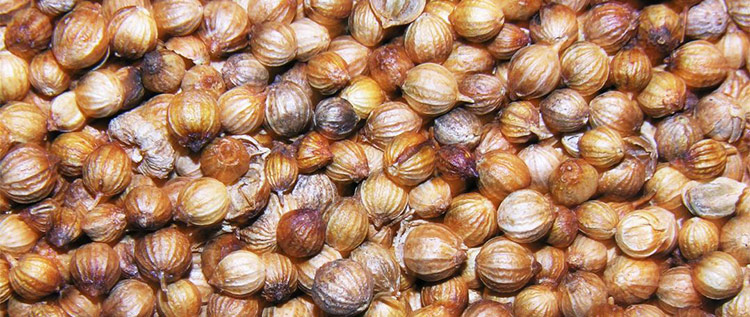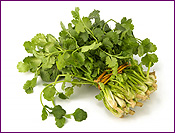Coriander Seed Essential Oil and Cilantro Leaf Essential Oil
Coriandrum sativum

Description
Coriandrum sativum is the botanical name for this intriguing plant. Both a seed oil and a leaf oil is commonly produced. Each oil offers different properties, so it is important to know whether you are working with the leaf oil or the seed oil.

The common names most typically used to refer to the seed oil are Coriander Seed Oil or simply as Coriander Oil. For the leaf oil, you may hear it commonly referred to as either Cilantro Oil, Cilantro Leaf Oil, or Coriander Leaf Essential Oil. If it doubt, doublecheck with the supplier.
Coriander Seed Essential Oil
Coriander Seed Essential Oil is an invigorating, stimulating oil. It is often noted for its use in aiding digestion and in assisting with aches, pains and arthritis.
American College of Healthcare Sciences principal Dorene Petersen has undertaken research regarding cognitive and brain health. She presents that Coriander Seed Oil shows promise for management of neurodegenerative diseases. [Dorene Petersen, Presentation: Clinical Use of Aromatherapy for Brain Health: 7 Essential Oils. August 9, 2017, New Brunswick, NJ. Alliance of International Aromatherapists 2017 Conference. AIA 2017 Conference Proceedings page 221-222.]
In addition to its therapeutic benefits, Coriander Seed Essential Oil is a slightly fruity, spicy oil that is well suited for use within natural fragrancing applications. I love it year around, but it is especially lovely to use during the fall and winter seasons. Some consider it an aphrodisiac.
Cilantro Leaf Essential Oil

Back in the 1980s, it was hard to find fresh cilantro in my area (or I just didn't know where to look at the time). I became more curious about it through a friend who traveled frequently to Mexico as a missionary. He FedExed me a care package of fresh and canned goodies directly from Mexico after crossing right back into Texas. Sadly, the package was delayed after traveling through high heat conditions. When I opened the box, the strong, unfamiliar aroma of rotting cilantro overpowered my kitchen. I'm sad that I disliked the aroma so much as really, the generous and thoughtful intentions of my dear friend meant so much to me.
Aside from my aversion to Wintergreen and Birch (it's the methyl salicylate that I can't tolerate well aromatically), I believe the only other herb/essential oil that I have an aversion to is the aroma of cilantro. I haven't worked with it enough to offer much personal insight into the leaf oil or offer an objective description of its aroma.
Coriander Seed Essential Oil Properties, Benefits and Uses
- Analgesic
- Aperitif
- Antispasmodic
- Bactericidal
- Depurative
- Digestive
- Carminative
- Stimulant
- Stomachic
Source: Salvatore Battaglia, The Complete Guide to Aromatherapy (Australia: The Perfect Potion, 2003), 286.
Botanical Name
Plant Family
Common Method of Extraction
Steam Distilled
Plant Part Typically Used
Color
Pale Yellow
Consistency
Medium
Perfumery Note
Middle
Strength of Initial Aroma
Medium
Aromatic Description
Coriander Seed Essential Oil smells sweet, herbaceous, spicy, woody and slightly fruity.
Coriander Seed Essential Oil Uses
- Aches
- Arthritis
- Colic
- Fatigue
- Grout
- Indigestion
- Nausea
- Rheumatism
Source: Julia Lawless, The Encyclopedia of Essential Oils (Updated Edition) (London: Harper Thorsons, 2014), 77-78.
Cognitive support and brain health. [Dorene Petersen, Presentation: Clinical Use of Aromatherapy for Brain Health: 7 Essential Oils. August 9, 2017, New Brunswick, NJ. Alliance of International Aromatherapists 2017 Conference. AIA 2017 Conference Proceedings page 221-222.]
Major Constituents for the Seed Oil
- Linalool
- a-Pinene
- Gamma-Terpinene
- B-Pinene
- p-Cymene
See Essential Oil Safety for a more complete list of typical constituents.
Source: B.M. Lawrence, Essential Oils 1988-1991 (Wheaton: Allured Publishing, 1993), 128-130, 182-183. Source cited in Robert Tisserand and Rodney Young, Essential Oil Safety (Second Edition. United Kingdom: Churchill Livingstone Elsevier, 2014), 259-260.
Major Constituents for the Leaf Oil
(E)-2-Decenal
Decanal, Linalool, Octanal
(E)-2-Dodecenal
2-Decen-1-ol
See Essential Oil Safety for a more complete list of constituents.
[B.M. Lawrence, Essential Oils 1988-1991 (Wheaton: Allured Publishing, 1993), 128-130, 182-183. Source cited in Robert Tisserand and Rodney Young, Essential Oil Safety (Second Edition. United Kingdom: Churchill Livingstone Elsevier, 2014), 259-260.]
Coriander Essential Oil Safety Information
Tisserand and Young do not indicate any known hazards for Coriander Seed Oil or Coriander Leaf Oil (Cilantro Oil). Reading Tisserand and Young's full profiles for these two oils is recommended. [Robert Tisserand and Rodney Young, Essential Oil Safety (Second Edition. United Kingdom: Churchill Livingstone Elsevier, 2014), 259-261.]
Coriander Seed CO2 Supercritical Select Extract
In addition to being available as an essential oil, this botanical is available from a small number of reputable sources as a CO2 extract. CO2 extracts offer many advantages. However, they can have differing safety precautions than essential oils because the natural chemistry of CO2 extracts can differ from their essential oil counterparts. Not much safety information is documented from trusted sources for CO2 extracts. Use CO2 extracts with great care and do not assume that every CO2 extract has the same safety precautions as its essential oil counterpart.
General Safety Information
Do not take any oils internally and do not apply undiluted essential oils, absolutes, CO2s or other concentrated essences onto the skin without advanced essential oil knowledge or consultation from a qualified aromatherapy practitioner. For general dilution information, read AromaWeb's Guide to Diluting Essential Oils. If you are pregnant, epileptic, have liver damage, have cancer, or have any other medical problem, use oils only under the proper guidance of a qualified aromatherapy practitioner. Use extreme caution when using oils with children and be sure to first read the recommended dilution ratios for children. Consult a qualified aromatherapy practitioner before using oils with children, the elderly, if you have medical issues or are taking medications. Before using this or any essential oil, carefully read AromaWeb's Essential Oil Safety Information page. For in-depth information on oil safety issues, read Essential Oil Safety by Robert Tisserand and Rodney Young.
Shelf Life
Important Information About the Profiles
The essential oil information provided on AromaWeb is intended for basic educational purposes only. The references to safety information, test results, constituents and percentages is generalized information. Essential oils can vary greatly in composition. The data is not necessary complete and is not guaranteed to be accurate. The essential oil photos are intended to represent the typical and approximate color of each essential oil. However, essential oil composition and color can vary based on harvesting, distillation, age of the essential oil and other factors. Profiles for several CO2 Extracts and absolutes are included within the directory, and are denoted as such.
